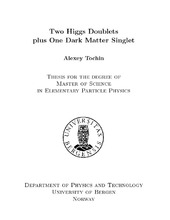Two Higgs Doublets plus One Dark Matter Singlet
Master thesis
Permanent lenke
https://hdl.handle.net/1956/4723Utgivelsesdato
2010-08-01Metadata
Vis full innførselSamlinger
Sammendrag
In this thesis an extension of the 2HDM (see chapter 1) is explored. The extension admits an extra inert singlet which is a dark matter candidate. Before the exploration a large part of the thesis (chapter 2) is an overview of dark matter theory that includes the evidence of dark matter existence, list of the most popular candidates, information of experimental detection and others. The phenomenology of the relic abundance is discussed in detail. Scanning over parameters of the considered model the abundance of the dark matter is constrained in agreement with WMAP data. Imposing all relevant collider and theoretical constraints the allowed parameter space for which dark matter is appropriate will be determined. It is done using two methods. The first one is to draw histograms of allowed regions with some parameters fixed and others are arbitrary (chapter 3). The second method is to draw scatter plots where all parameters are random (chapter 4). The important case of the theory with quadratic divergency cancellation will be discussed in chapter 4 together with the usual one. Some attempts to use different numerical methods (appendices A and B) of searching for such allowed regions in the parametric space are presented. But it is rather a training of them than an active application or at least an attempt to find any new method of the calculation optimization.
Utgiver
The University of BergenOpphavsrett
The authorCopyright the author. All rights reserved
